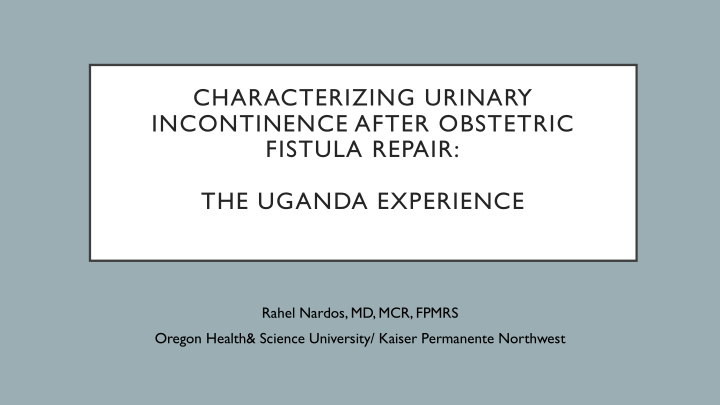



CHARACTERIZING URINARY INCONTINENCE AFTER OBSTETRIC FISTULA REPAIR: THE UGANDA EXPERIENCE Rahel Nardos, MD, MCR, FPMRS Oregon Health& Science University/ Kaiser Permanente Northwest
DISCLOSURE • I have no relevant financial relationships to disclose
BACKGROUND • Uganda has one of the highest prevalence of obstetric vesicovaginal fistula in the world, estimated at 2.6% (1) • Many women continue to have persistent incontinence after their fistulas have been successfully closed • Estimates of persistent incontinence range from 7-40% (2-3) • The etiology of persistent incontinence is likely multifactorial 1. McCurdie FK, Moffatt J, Jones K. Vesicovaginal fistula in Uganda. J Obstet Gynaecol. 2018;38(6):822-827. 2. Browning, A., & Menber, B. (2008). Women with obstetric fistula in Ethiopia: a 6-month follow up after surgical treatment. BJOG : An International Journal of Obstetrics and Gynaecology , 115 (12), 1564–9 3. Gutman, R. E., Dodson, J. L., & Mostwin, J. L. (2007). Complications of treatment of obstetric fistula in the developing world: gynatresia, urinary incontinence, and urinary diversion. International Journal of Gynaecology and Obstetrics: The Official Organ of the International Federation of Gynaecology and Obstetrics , 99 Suppl 1 , S57–64
OBJECTIVE • Characterize persistent urinary incontinence after fistula • Type • Severity • Assess the impact of post-fistula incontinence on • Quality of life • Psychological wellbeing • Raise awareness to the ongoing chronic medical needs of obstetric fistula patients.
METHODS • IRB obtained from Makerere University and Oregon Health & Science University • Enrolled women ages 18-80 with a history of obstetric fistula • With persistent incontinence (Cases: N=36) • Without persistent incontinence ( Controls: N=52) • Data collected from patients in Central and Eastern Uganda from 2017-2019 • Project conducted in partnership with Terrewode, an NGO in Uganda that provides post-fistula reintegration program. • Exclusion Criteria : current pregnancy or obstetric fistula
METHODS ASSESSMENT TOOLS • Semi-structured questionnaire 1 • Demographics 2 • Psychological, medical, economic and treatment seeking behavior • Severity of incontinence assessed using: 3 • Post-Fistula Incontinence Severity Scale (PFISS) • International Consultation on Incontinence Questionnaire Short Form 4 ( ICIQ-SF) • 2-hour Pad test 5 • Bladder diary : Color coded paper strips • Impact on quality of life assessed using: 6 • ICIQ-QOL • Exam: Dye test and Cough stress test 7
RESULTS Demographics Controls (n=52) Cases (n=36) P-value Age 30.32 ± 9.86 34.68 ± 11.82 0.06 Age at first Marriage 17.50 ± 2.81 17.51 ± 2.57 0.98 Age at first Delivery 18.13 ± 2.35 17.68 ± 2.80 0.42 Age at first fistula 24.78 ± 7.46 20.28 ± 5.84 0.003 Number of fistula surgeries <2 51 (98%) 13 (36%) 0.001 >2 1 (2%) 23 (64%) No of Deliveries before fistula None 19 (37%) 22 (63%) 0.02 >1 33 (63%) 13 (37%) Marital status Married 30 (58%) 15 (42%) 0.08 Widowed/Separated 15 (29%) 19 (53%) Never married 7 (13%) 2 (5%)
RESULT • Clinical assessments • 97% of cases had positive cough stress test Type of incontinence • 86% of cases had 2 hour Pad weight of >4 Stress 67% grams Urgency 47% Mixed 71% • Bladder diary Post-void dribbling 31% • Average leaks/day: 20 Leaks all the time 53% • Average bladder capacity : 150ml • Average voids/day: 13.6
RESULTS • Significant psychological burden • 33% of controls and 42% of cases have had frequent suicidal ideation • 8% in each group ( cases and controls) have attempted suicide • 17% of controls and 25% of cases have had plans for suicide • Severe urinary incontinence • 83% Cases perceived their incontinence to be severe (ICIQ-SF 13-18) or very severe ( ICIQ- SF 19-21). • Moderate positive correlation between ICIQ-SF and PFISS (cc =0.47) • Significant Impact on quality of life • Mean ICIQ-QOL score of 62.8+12.8 (scores normally range from 19-76) • Moderate positive correlation between ICIQ-SF and ICIQ-QOL (cc=0.60)
CONCLUSION • Persistent incontinence after obstetric fistula is associated with • A younger age at first fistula • A history of more than two obstetric fistula • Most post fistula incontinence is mixed (71%), characterized by urgency (47%) and stress( 67%) incontinence. • Women who have persistent urinary incontinence after fistula have severe incontinence that has high negative impact on their quality of life and psychological wellbeing. • Our model of Obstetric fistula care should be expanded to address the more chronic and debilitating medical condition of persistent incontinence
LIMITATIONS • Unable to make clinical correlations such as stage of fistula, surgical history, obstetric history etc. • Not able to perform more complex bladder evaluations such as urodynamics
ACKNOWLEDGEMENT • Worldwide fistula fund • OHSU Global Health Student Fund • Terrewode ( Fistula Reintegration Program in Uganda) • Alice Emasu, MSW • Bonnie Ruder, PhD • Katie Cobb
Recommend
More recommend